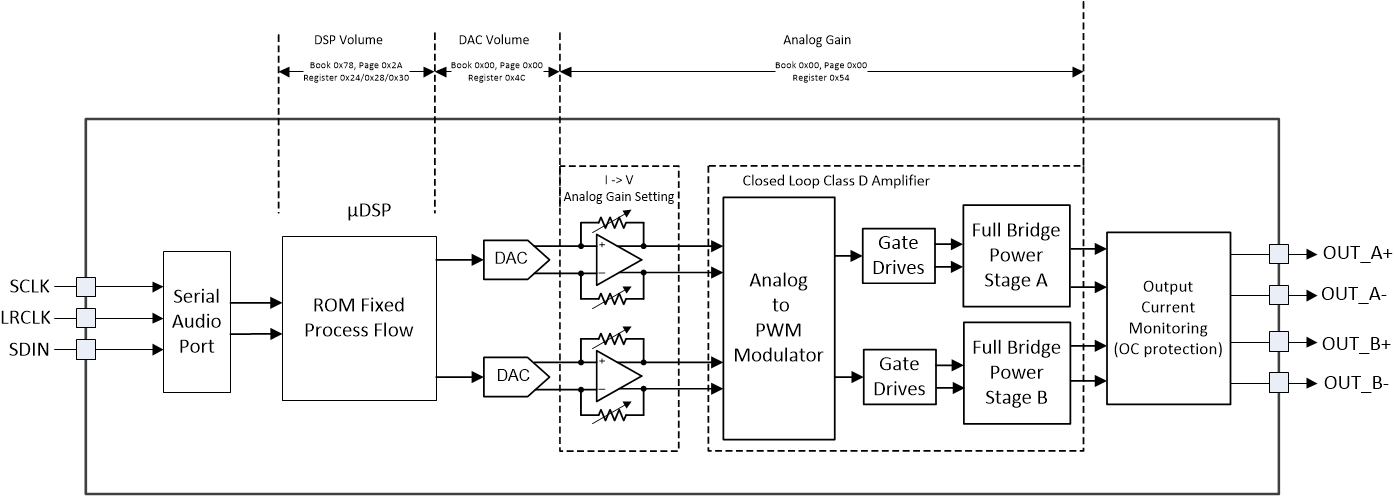ZHCSMV1 December 2020 TAS5822M
PRODUCTION DATA
- 1 特性
- 2 应用
- 3 说明
- 4 Revision History
- 5 Pin Configuration and Functions
- 6 Specifications
-
7 Detailed Description
- 7.1 Overview
- 7.2 Functional Block Diagram
- 7.3 Feature Description
- 7.4 Device Functional Modes
- 7.5 Programming and Control
- 7.6 Register Maps
- 8 Application and Implementation
- 9 Power Supply Recommendations
- 10Layout
- 11Device and Documentation Support
- 12Mechanical, Packaging, and Orderable Information
7.3.8.1 Speaker Amplifier Gain Select
A combination of digital gain and analog gain is used to provide the overall gain of the speaker amplifier. As seen in Figure 7-8, the audio path of the device consists of a digital audio input port, a digital audio path, a stereo DAC, an analog to PWM modulator, a gate driver stage, a Class D power stage, and a feedback loop which feeds the output information back into the analog to PWM Modulator to correct for distortion sensed on the output pins. The total amplifier gain is comprised of digital gain, shown in the digital audio path and the analog gain from the input of the analog modulator to the output of the speaker amplifier power stage.
 Figure 7-8 Speaker Amplifier Gain
Figure 7-8 Speaker Amplifier GainAs shown in Figure 7-8, the first gain stage for the speaker amplifier is present in the digital audio path. It consists of the DSP volume control and the DAC volume control. The volume control is set to 0dB by default. For all settings of the Register 0x54, AGAIN[4:0], the digital boost block remains at 0 dB. These gain settings ensure that the output signal is not clipping at different PVDD levels. 0dBFS output is 29.5-V peak output voltage
| AGAIN[4:0] | GAIN (dBFS) | AMPLIFIER OUTPUT PEAK VOLTAGE (VP/FS) | AMPLIFIER OUTPUT PEAK VOLTAGE (dBV/FS) |
|---|---|---|---|
| 00000 (Default Setting) | 0 (Default Setting) | 29.5VP/FS (Default Setting) | 29.4dBV |
| 00001 | -0.5 | 27.85VP/FS | 28.9dBV |
| 00010 | -1.0 | 26.29VP/FS | 28.4dBV |
| 00011 | -1.5 | 24.82VP/FS | 27.9dBV |
| ……. | …….. | ……. | .... |
| 11111 | -15.5 | 4.95VP/FS | 13.9dBV |
(Based on 6Ω speaker Load, take 0.5Ω loss for PCB, Speaker wire, Inductor DCR and RDSon)
| DAC Input (µDSP Output) dBFS | Full Band AGL Threshold dBFS | PVDD V | Book0/Page0, Register 0x54, AGAIN[4:0] | Gain (dBFS) | Amplifier Output Peak Voltage V | Amplifier Output Peak Voltage dBV |
|---|---|---|---|---|---|---|
| 0 | 0 | 24 | 00101 | -2.5 | 22.5V (Without Clipping) | 27dBV |
| 18 | 01010 | -5 | 16.6V (Without Clipping) | 24.35dBV | ||
| 13.5 | 01111 | -7.5 | 12.46V (Without Clipping) | 21.9dBV | ||
| -2.5 | -2.5 | 24 | 00000 | 0 | 22.5V (Clipping or not, depends on AGL time constant tuning) | 27dBV |
| -5 | -5 | 18 | 16.6V (Clipping or not, depends on AGL time constant tuning) | 24.35dBV | ||
| -7.5 | -7.5 | 13.5 | 12.46V (Clipping or not, depends on AGL time constant tuning) | 21.9dBV |